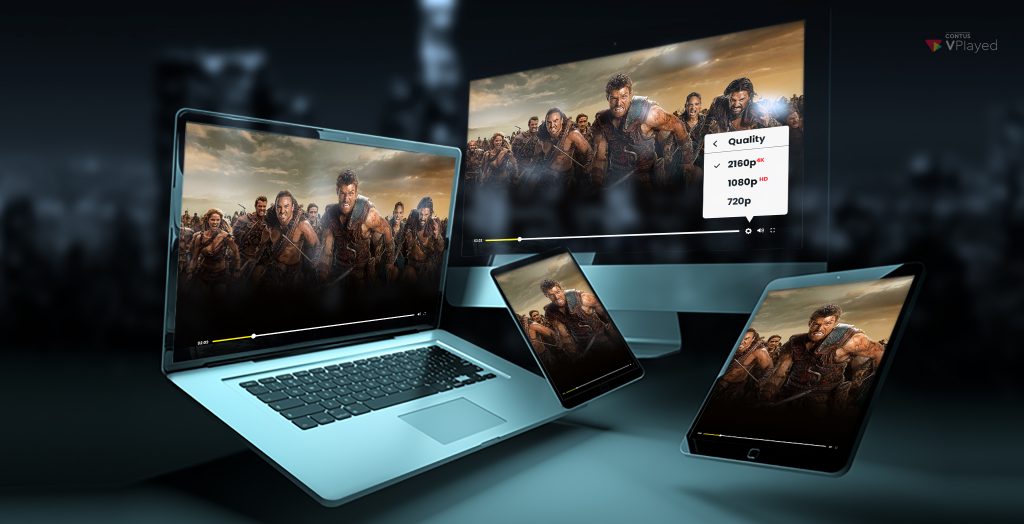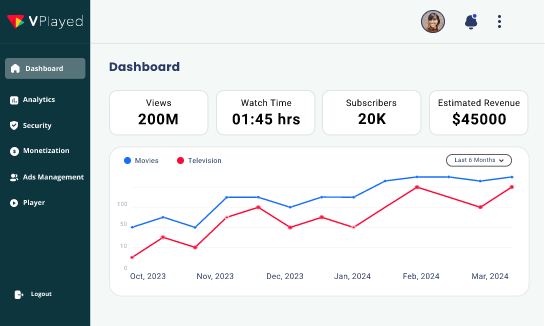What is Video Transcoding? Why is it Essential for OTT Streaming?

The fact that video consumption contributes to over 80% of the total Internet traffic is game-changing, and OTT is one major reason why the media industry is the way it is.
Thanks to the wide variety of display devices that have evolved over the years in making over-the-top technology one of the most adopted ways for viewing content.
But, for a captured video to reach an end-user device in the right quality for an enhanced viewer experience demands more than mere broadcasting. A multitude of file formats that are compatible with a wider range of platforms/ players is what can make a piece of content fetch the reach it intended to.
And this is where, as a content producer, you ought to understand the significance of encoding and transcoding in a streaming workflow.
Table of Contents
What is Video Transcoding?
“Video transcoding is the process of converting encoded data from one form to another involving change in 3 key elements of an uploaded video — the file format, resolution, and framerate.”
In simple terms, Transcoding is particularly useful when users want to serve media without much buffering to multiple target devices like mobile phones, web, or smart TV, assuring a positive and stutter-free user experience.
The OTT Transcoding Workflow
Here’s illustrating the step-by-step process of how transcoding works:
Input Stages:
1. Upload encoded content
The video is re-formatted so that any device can recognize and interpret the data. HLS (HTTP Live Streaming) supports H.264 & H.265 encoding.
2. Create a pipeline in encoder specifying the input source (encoder output) & the output destination; set the necessary privileges to access video output.
3. Create a job:
- Mention the pipeline info
- Input format (eg: MP4 with H.264), output format (.m3u8 with H.264)
- Resolution presets (360p, 480p, 720,1080p etc..)
- Framerate per preset
- Bitrate per preset
- Segment duration (3 to 10 sec)
- Create thumbnails (if required)
- Provide thumbnail format
- Add caption inputs (.srt/webvtt) [if required]
- Add audio inputs (AAC/MP3 format)
4. Security inputs:
Add a security key from any of the following based on your industry for piracy-free video streaming.
- Digital watermark
- AES 128 key
- DRM key
5. Playlist settings:
Playlist helps to refer to the output group while streaming video in the player.
Output:
Jobs are nothing until submitted to a Queue. After job submission, they are processed strictly & rendered final output. The output would be .ts file segment which is a small chunk potential to play a few seconds of a video which refers to the .M3U8 playlist file for sequencing.
TS File:
HLS is built on top of MPEG-TS. Video is formatted as an MPEG Transport Stream. Audio can be formatted either as an MPEG-TS or raw AAC/MP3 frames.
The sample output would be :
#EXTM3U
#EXT-X-VERSION:3
#EXT-X-SESSION-KEY:METHOD=AES-128, URI=”domain.com/validate-auth”
#EXT-X-INDEPENDENT-SEGMENTS
#EXT-X-STREAM-INF:BANDWIDTH=881587,AVERAGE-BANDWIDTH=820965,
CODECS=”avc1.77.30,mp4a.40.2″,
RESOLUTION=854×480,
FRAME-RATE=25.000,
hdntl=exp=1641348982~acl=%2f*~data=hdntl~hmac=b70f30070ad8d18270d33d0884379b487878b633b21dcba9cc54c36f9a4141fc/playlist1632391737926-segments-1.m3u8

Why is Transcoding Crucial for OTT Streaming?
With the amount of time, energy, and money that has gone into filming or acquiring a video, it is essential that it reaches maximum audiences for expected ROIs. Hence, the more the content owner wants to distribute his video, the higher the need for transcoding in the OTT Streaming space.
1. Multiple File Formats
The inefficiency to deliver your valuable content to a multitude of display devices can be daunting. However, transcoding eases the process, helping create different versions of the same piece of content with different file formats (HLS or DASH), and enabling multiplayer/ platform compatibility.
2. Facilitates ABR (Adaptive Bitrate Streaming)
“Adaptive Bitrate Streaming is a technique used to stream multimedia with various resolution content over HTTP at different bitrates and resolutions according to the user’s bandwidth & screen size.”
By having multiple versions of the same video, the player dynamically switches between resolutions (eg: from a source format of 1080p to 720p) depending on the Internet connection of the end-user. This is particularly useful in cases where there is fluctuating connectivity and also promotes buffer-free streaming with reduced bandwidth requirements.
To achieve ABR, the streaming video undergoes two main conversions namely,
Transrating: Refers to changing bitrates (Eg: Converting 4K video input streams at 13 Mbps into lower-bitrate streams at 6Mbps,3 Mbps, 1.8 Mbps, 1 Mbps, or 600 kbps)
Trans Sizing: Refers to resizing the video frame (Eg: Sizing down from a resolution of 3840×2160 (4K UHD) to 1080p 720p, 480p, or 360p)
Recommended Read: How is Adaptive Bitrate Streaming Optimized for User Experience?
How Does Transcoding Support Streaming Services?
As Internet penetration continues to rise, there has been an unprecedented growth of streaming platforms around the globe. And the ultimate aim being maximum reach, visibility and viewership, transcoding is what helps content owners across niches achieve increased monetary benefits in the longer run. Here’s listing how streaming businesses make the most of this media conversion technology.
i) Low-Latency Video Delivery
As mentioned above, in the absence of transcoding, audiences without sufficient bandwidth might miss out on your HD video offering, be it on-demand or live streaming. Hence, transcoding eliminates buffering and thus promotes streaming platforms to deliver the most efficient video quality.
ii) Enhanced QoE (Quality of Experience)
When it comes to the OTT platform, a one-size-fits-all formula hardly works. Transcoding paves the way for multiple playback options for the end-user, assuring quick startup/ faster loading times, enhanced video quality, and reduced playback failure due to network inconsistencies with the help of multiple bitrates and resolutions.
iii) Saves Viewer’s Data Costs
Since the streams delivered are based on the bandwidth available, it eases the load off the user’s player and reduces the data costs for the end-user. This again is a positive viewer experience and benefits the streaming platform.
Popular Video Transcoding Tools/ Services
Transcoding can potentially happen via software on a dedicated media server, Cloud or a SaaS platform but requires substantial hardware resources & tools to be scalable according to the bandwidth of the input.
| FFMPEG | An opensource tool combined with multimedia packages that supports encoding, transcoding, & packaging the media files. But it would require a robust inbuilt framework backed by a strong engineering team. |
| AWS elemental media convert | AWS has built the complete ecosystem, everything from video ingestion to distribution operates on a recurring fee or consumption-based pricing model. Widely used by top multimedia providers. |
| Azure media services | Offers different packages under media services that support low-latency live streaming, batch transcoding, content-protection/DRM, and delivers streaming content across all users. |
| Google Transcoder service | A recent launch from Google to offer transcoding services; but lacks a few features compared to AWS. |
Things to Look for in a Video Transcoding Center
Right from content creation/ acquisition to launching your own platform and then to bring in traffic, there is a lot that goes on with an OTT business.
Hence, the first and foremost pointer on the list is to make sure your platform is integrated with a transcoding center. This eases most of the burden off the broadcaster’s shoulders since the video uploaded is automatically transcoded to different bitrates, all set for appropriate streaming.
Secondly comes the need to ensure the number of renditions your transcoder is set to deliver. With more device compatibility comes greater viewership from audiences which, in turn, will ramp up the income generated in a streaming business through wider reach.
In summary,
Transcoding is an integral part of any streaming infrastructure because of the different renditions it offers of the same piece of video content to reach a diverse range of screens/ display devices. Besides enhancing the playback capabilities, it minimizes the complexity, thus boosting startup times at the user end.
At the end of the day, it is a buffer-free stream that matters for a positive viewer experience and hence it is highly essential that content owners opt for a streaming solution that encompasses automatic transcoding features for impressive throughput.
